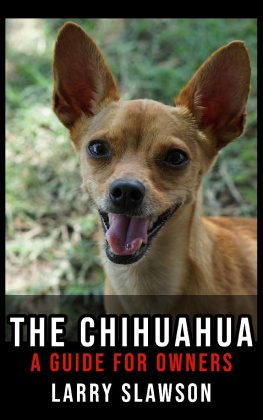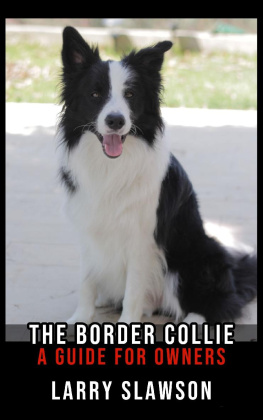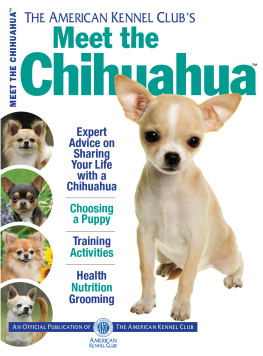Larry Slawson - The Chihuahua: A Guide for Owners
Here you can read online Larry Slawson - The Chihuahua: A Guide for Owners full text of the book (entire story) in english for free. Download pdf and epub, get meaning, cover and reviews about this ebook. year: 2020, publisher: Larry Slawson, genre: Home and family. Description of the work, (preface) as well as reviews are available. Best literature library LitArk.com created for fans of good reading and offers a wide selection of genres:
Romance novel
Science fiction
Adventure
Detective
Science
History
Home and family
Prose
Art
Politics
Computer
Non-fiction
Religion
Business
Children
Humor
Choose a favorite category and find really read worthwhile books. Enjoy immersion in the world of imagination, feel the emotions of the characters or learn something new for yourself, make an fascinating discovery.
- Book:The Chihuahua: A Guide for Owners
- Author:
- Publisher:Larry Slawson
- Genre:
- Year:2020
- Rating:4 / 5
- Favourites:Add to favourites
- Your mark:
- 80
- 1
- 2
- 3
- 4
- 5
The Chihuahua: A Guide for Owners: summary, description and annotation
We offer to read an annotation, description, summary or preface (depends on what the author of the book "The Chihuahua: A Guide for Owners" wrote himself). If you haven't found the necessary information about the book — write in the comments, we will try to find it.
The Chihuahua: A Guide for Owners — read online for free the complete book (whole text) full work
Below is the text of the book, divided by pages. System saving the place of the last page read, allows you to conveniently read the book "The Chihuahua: A Guide for Owners" online for free, without having to search again every time where you left off. Put a bookmark, and you can go to the page where you finished reading at any time.
Font size:
Interval:
Bookmark:
Throughout the world, there exists only a handful of dog breeds that can be consistently described as courageous, loyal, and devoted. One of these dogs is the Chihuahua. Although originally bred for ceremonial purposes, this breed is now favored for its steadfast loyalty and companionship qualities (making it an ideal choice for families and elderly individuals). This work examines the Chihuahua and provides an in-depth analysis of the animals behavioral patterns, temperament, and general traits. It is the authors hope that a better understanding (and appreciation) of this remarkable breed will accompany readers following their completion of this work.
- Common Name: Chihuahua
- Binomial Name:Canis Lupus Familiaris
- Kingdom: Animalia
- Phylum: Chordata
- Class: Mammalia
- Order: Carnivora
- Family: Canidae
- Genus: Canis
- Species:Canis Lupus
- Subspecies:Canis Lupus Familiaris
- Other Name(s): N/A
- Lifespan: 14 to 18 years
- Group: Toy
- Area of Origin: Mexico
- Date of Origin: 1500s
- Original Purpose: Companionship; Ceremonial
- Modern Function: Companionship
- Family: Primitive
Origins
Considered the smallest dog breed in the world, little is known about the Chihuahuas origins. Some theories suggest that the dog may have originated in China before being brought to Mexico by Spanish traders in the 1500s. Others suggest that the breed originated (entirely) in Central and South America. The latter theory is generally accepted more than others, as evidence tends to suggest that the Chihuahua was a major part of ceremonial rituals within the Techichi, Toltec, and Aztec religions. As an unfortunate part of these rituals, however, many Chihuahuas are believed to have been sacrificed as it was believed by the Aztecs that small dogs helped guide souls to the underworld (Coile, 220).
A final theory to the Chihuahuas origins mixes these two theories, and suggests that the Chihuahua was originally a small breed from Central America that was crossed with hairless Chinese dogs brought to the New World by Spaniards. Until greater evidence can be uncovered though, these theories will continue to remain speculative, at best.
Modern Function
Following the destruction of the Aztec culture by Cortes (in the 16th Century), historians believe that the Chihuahua was abandoned and forced to fend for themselves in the wild. It wasnt until the mid-1800s that three of these dogs were found in Chihuahua, Mexico (hence their name) and were brought back to the United States. And while the newfound Chihuahua initially garnered little attention, the world-famous Xavier Cugat (a famous Spanish musician) helped make the dog popular during the 1900s by always appearing in public with a Chihuahua in-hand. Today, the Chihuahua is one of the most popular breeds in the United States and is favored for its adorable size, personality, and steadfast devotion to owners.
Body
- Weight: Less than 6 pounds (male and female)
- Height: 6 to 9 inches (male and female)
The Chihuahua is a well-balanced dog that rarely exceeds 6-pounds in its overall weight. Their bodies are relatively long, with shoulder width being proportionate to the overall length of the back. Ribs should also be well-sprung.
Head
Chihuahuas possess well-rounded skulls that are accentuated by round and luminous eyes. Ears are typically large and erect in appearance, and generally flare at the sides following a 45-degree angle. Muzzles are, on average, quite short and follow a pointed appearance. Completing the muzzle area is a lean series of cheeks and jaws.
Forequarters
Forequarters on the Chihuahua are quite lean (due to their small size), with shoulders following a sloped appearance. Likewise, the chest should display a series of well-sprung ribs. Completing the forequarters is a pair of straight (slim) legs that are connected to small, cushioned feet with split toes. Dewclaws if present may be removed if desired.
Hindquarters
Similar to the forequarters, the Chihuahuas hindquarters are muscular (but also lean) in appearance, with the hocks set well apart. Legs should be slightly angled, with the feet the same as the front (small with split toes).
Tail
Tails on the Chihuahua are relatively long and follow a sickle-like appearance. Generally speaking, tails tend to be carried outward (or upwards), and can occasionally loop over the dogs back.
Coat and Coloration
Overall coats vary between Chihuahua breeds, and come in smooth or long varieties. Smooth coats should be soft, close, and glossy in appearance, whereas longer coats will follow a soft and wave-like texture.
The Chihuahua also comes in a variety of colors including cream, gold, fawn, red, sable, chocolate, blue, bicolor, tricolor, as well as black and tan. In more recent years, merles (a combination of irregular dark and light splotches) has also been introduced by breeders with mixed reviews.
General Characteristics
- Energy Level: 5/5
- Exercise Needs: 1/5
- Playfulness: 2/5
- Affection Towards Owners: 5/5
- Friendliness Towards Other Animals: 2/5
- Training Difficulty: 3/5
- Grooming Level: 2/5
Note: Scale of 1 to 5 (1=Lowest, 5=Highest)
Temperament (Personality)
Despite their small size, the Chihuahua is one of the most fearless dog breeds in the world. Often described by experts as confident and bold, the Chihuahua makes for an excellent companion (and even a watch dog). Overconfidence and boldness, however, can also be seen as a negative series of traits for this breed as the Chihuahua can be quite stubborn and disobedient at times. They can also be quite hot-headed when provoked and will not back down to a fight (due to their excitable nature). Due to their natural intelligence though, these behaviors can often be corrected through regular obedience training.
In spite of these issues, potential owners should note that this breed is quite loving and affectionate towards their family, with an eagerness to please. Individuals will be hard-pressed to find another dog capable of displaying the love and admiration shown by a Chihuahua to their owner.
Are Chihuahuas Good With Children?
Yes! However, the Chihuahua is best suited for households with older children (outside of the toddler stage) as young kids can unknowingly cause serious harm or injury to a Chihuahua through mishandling. In spite of this, Chihuahuas are known for their lovable nature towards owners, and often do well with children. It is important to note, however, that this breed has a strong tendency to form attachments with a single individual in the household. As a result, they can sometimes become nippy when others get too close to their preferred family member.
How Smart is the Chihuahua?
While the Chihuahua doesnt make the Top 10 list for smartest dog breeds, they are incredibly smart little dogs with the ability to process information and to learn quickly. While new tricks are often difficult for this breed to learn (requiring upwards of 40 to 80 repetitions of an action in order to learn), experts have regularly demonstrated that the Chihuahua possesses an adaptive and instinctive intelligence that is often higher than most breeds. Adaptive intelligence simply means that the Chihuahua is capable of learning from past mistakes (i.e. not making the same mistake twice). Instinctive, on the other hand, stems from the dogs companionship qualities and refers to the Chihuahuas natural ability to respond to (and understand) human emotions and needs. So while obedience and retrieving will be difficult for the Chihuahua to learn, owners will be hard-pressed to find another dog breed capable of responding to their emotional states like this tiny dog.
Font size:
Interval:
Bookmark:
Similar books «The Chihuahua: A Guide for Owners»
Look at similar books to The Chihuahua: A Guide for Owners. We have selected literature similar in name and meaning in the hope of providing readers with more options to find new, interesting, not yet read works.
Discussion, reviews of the book The Chihuahua: A Guide for Owners and just readers' own opinions. Leave your comments, write what you think about the work, its meaning or the main characters. Specify what exactly you liked and what you didn't like, and why you think so.












